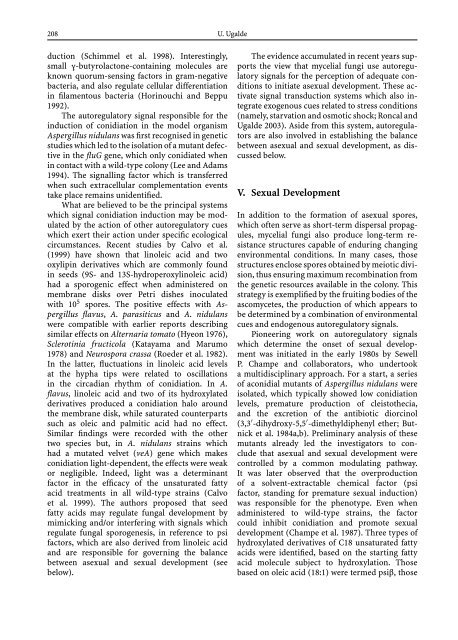Growth, Differentiation and Sexuality
Growth, Differentiation and Sexuality
Growth, Differentiation and Sexuality
Create successful ePaper yourself
Turn your PDF publications into a flip-book with our unique Google optimized e-Paper software.
208 U. Ugalde<br />
duction (Schimmel et al. 1998). Interestingly,<br />
small γ-butyrolactone-containing molecules are<br />
known quorum-sensing factors in gram-negative<br />
bacteria, <strong>and</strong> also regulate cellular differentiation<br />
in filamentous bacteria (Horinouchi <strong>and</strong> Beppu<br />
1992).<br />
The autoregulatory signal responsible for the<br />
induction of conidiation in the model organism<br />
Aspergillus nidulans was first recognised in genetic<br />
studies which led to the isolation of a mutant defective<br />
in the fluG gene, which only conidiated when<br />
in contact with a wild-type colony (Lee <strong>and</strong> Adams<br />
1994). The signalling factor which is transferred<br />
when such extracellular complementation events<br />
take place remains unidentified.<br />
What are believed to be the principal systems<br />
which signal conidiation induction may be modulated<br />
by the action of other autoregulatory cues<br />
which exert their action under specific ecological<br />
circumstances. Recent studies by Calvo et al.<br />
(1999) have shown that linoleic acid <strong>and</strong> two<br />
oxylipin derivatives which are commonly found<br />
in seeds (9S- <strong>and</strong> 13S-hydroperoxylinoleic acid)<br />
had a sporogenic effect when administered on<br />
membrane disks over Petri dishes inoculated<br />
with 10 5 spores. The positive effects with Aspergillus<br />
flavus, A. parasiticus <strong>and</strong> A. nidulans<br />
were compatible with earlier reports describing<br />
similar effects on Alternaria tomato (Hyeon 1976),<br />
Sclerotinia fructicola (Katayama <strong>and</strong> Marumo<br />
1978) <strong>and</strong> Neurospora crassa (Roeder et al. 1982).<br />
In the latter, fluctuations in linoleic acid levels<br />
at the hypha tips were related to oscillations<br />
in the circadian rhythm of conidiation. In A.<br />
flavus, linoleic acid <strong>and</strong> two of its hydroxylated<br />
derivatives produced a conidiation halo around<br />
the membrane disk, while saturated counterparts<br />
such as oleic <strong>and</strong> palmitic acid had no effect.<br />
Similar findings were recorded with the other<br />
two species but, in A. nidulans strains which<br />
had a mutated velvet (veA) gene which makes<br />
conidiation light-dependent, the effects were weak<br />
or negligible. Indeed, light was a determinant<br />
factor in the efficacy of the unsaturated fatty<br />
acid treatments in all wild-type strains (Calvo<br />
et al. 1999). The authors proposed that seed<br />
fatty acids may regulate fungal development by<br />
mimicking <strong>and</strong>/or interfering with signals which<br />
regulate fungal sporogenesis, in reference to psi<br />
factors, which are also derived from linoleic acid<br />
<strong>and</strong> are responsible for governing the balance<br />
between asexual <strong>and</strong> sexual development (see<br />
below).<br />
The evidence accumulated in recent years supports<br />
the view that mycelial fungi use autoregulatory<br />
signals for the perception of adequate conditions<br />
to initiate asexual development. These activate<br />
signal transduction systems which also integrate<br />
exogenous cues related to stress conditions<br />
(namely, starvation <strong>and</strong> osmotic shock; Roncal <strong>and</strong><br />
Ugalde 2003). Aside from this system, autoregulators<br />
are also involved in establishing the balance<br />
between asexual <strong>and</strong> sexual development, as discussed<br />
below.<br />
V. Sexual Development<br />
In addition to the formation of asexual spores,<br />
which often serve as short-term dispersal propagules,<br />
mycelial fungi also produce long-term resistance<br />
structures capable of enduring changing<br />
environmental conditions. In many cases, those<br />
structures enclose spores obtained by meiotic division,<br />
thus ensuring maximum recombination from<br />
the genetic resources available in the colony. This<br />
strategy is exemplified by the fruiting bodies of the<br />
ascomycetes, the production of which appears to<br />
be determined by a combination of environmental<br />
cues <strong>and</strong> endogenous autoregulatory signals.<br />
Pioneering work on autoregulatory signals<br />
which determine the onset of sexual development<br />
was initiated in the early 1980s by Sewell<br />
P. Champe <strong>and</strong> collaborators, who undertook<br />
a multidisciplinary approach. For a start, a series<br />
of aconidial mutants of Aspergillus nidulans were<br />
isolated, which typically showed low conidiation<br />
levels, premature production of cleistothecia,<br />
<strong>and</strong> the excretion of the antibiotic diorcinol<br />
(3,3 ′ -dihydroxy-5,5 ′ -dimethyldiphenyl ether; Butnick<br />
et al. 1984a,b). Preliminary analysis of these<br />
mutants already led the investigators to conclude<br />
that asexual <strong>and</strong> sexual development were<br />
controlled by a common modulating pathway.<br />
It was later observed that the overproduction<br />
of a solvent-extractable chemical factor (psi<br />
factor, st<strong>and</strong>ing for premature sexual induction)<br />
was responsible for the phenotype. Even when<br />
administered to wild-type strains, the factor<br />
could inhibit conidiation <strong>and</strong> promote sexual<br />
development (Champe et al. 1987). Three types of<br />
hydroxylated derivatives of C18 unsaturated fatty<br />
acids were identified, based on the starting fatty<br />
acid molecule subject to hydroxylation. Those<br />
based on oleic acid (18:1) were termed psiβ, those

















